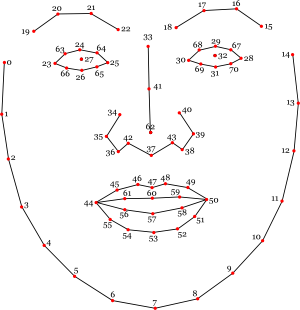= Web Interface
You can load index.html file from your browser or have a webserver of your choice pointing to this directory.
Webserver is mandatory if you want :
- to remotely control LJ : imagine LJ can be installed in a dedicated computer/container with no easy access.
- to use the face tracking, say from a smartphone. That's Lasercam (a clmtrackr plugin).
== Simu
A laser simulator. Choose lasernumber and it will display redis points for current scene/lasernumber
== clmtrackr
[](https://www.npmjs.com/package/clmtrackr)

**clmtrackr** is a javascript library for fitting facial models to faces in videos or images. It currently is an implementation of *constrained local models* fitted by *regularized landmark mean-shift*, as described in [Jason M. Saragih's paper](http://dl.acm.org/citation.cfm?id=1938021). **clmtrackr** tracks a face and outputs the coordinate positions of the face model as an array, following the numbering of the model below:
[](https://auduno.github.io/clmtrackr/examples/media/facemodel_numbering_new.png)
[Reference](http://auduno.github.io/clmtrackr/docs/reference.html) - [Overview](https://www.auduno.com/2014/01/05/fitting-faces/)
The library provides some generic face models that were trained on [the MUCT database](http://www.milbo.org/muct/) and some additional self-annotated images. Check out [clmtools](https://github.com/auduno/clmtools) for building your own models.
For tracking in video, it is recommended to use a browser with WebGL support, though the library should work on any modern browser.
For some more information about Constrained Local Models, take a look at Xiaoguang Yan's [excellent tutorial](https://sites.google.com/site/xgyanhome/home/projects/clm-implementation/ConstrainedLocalModel-tutorial%2Cv0.7.pdf?attredirects=0), which was of great help in implementing this library.
### Examples ###
* [Tracking in image](https://auduno.github.io/clmtrackr/examples/clm_image.html)
* [Tracking in video](https://auduno.github.io/clmtrackr/examples/clm_video.html)
* [Face substitution](https://auduno.github.io/clmtrackr/examples/facesubstitution.html)
* [Face masking](https://auduno.github.io/clmtrackr/examples/face_mask.html)
* [Realtime face deformation](https://auduno.github.io/clmtrackr/examples/facedeform.html)
* [Emotion detection](https://auduno.github.io/clmtrackr/examples/clm_emotiondetection.html)
* [Caricature](https://auduno.github.io/clmtrackr/examples/caricature.html)
### Usage ###
Download the minified library [clmtrackr.js](https://github.com/auduno/clmtrackr/raw/dev/build/clmtrackr.js), and include it in your webpage.
```html
/* clmtrackr libraries */
```
The following code initiates the clmtrackr with the default model (see the [reference](http://auduno.github.io/clmtrackr/docs/reference.html) for some alternative models), and starts the tracker running on a video element.
```html
```
You can now get the positions of the tracked facial features as an array via ```getCurrentPosition()```:
```html
```
You can also use the built in function ```draw()``` to draw the tracked facial model on a canvas :
```html
```
See the complete example [here](https://auduno.github.io/clmtrackr/examples/example.html).
### Development ###
First, install [node.js](http://nodejs.org/) with npm.
In the root directory of clmtrackr, run `npm install` then run `npm run build`. This will create `clmtrackr.js` and `clmtrackr.module.js` in `build` folder.
To test the examples locally, you need to run a local server. One easy way to do this is to install `http-server`, a small node.js utility: `npm install -g http-server`. Then run `http-server` in the root of clmtrackr and go to `https://localhost:8080/examples` in your browser.
### License ###
**clmtrackr** is distributed under the [MIT License](http://www.opensource.org/licenses/MIT)